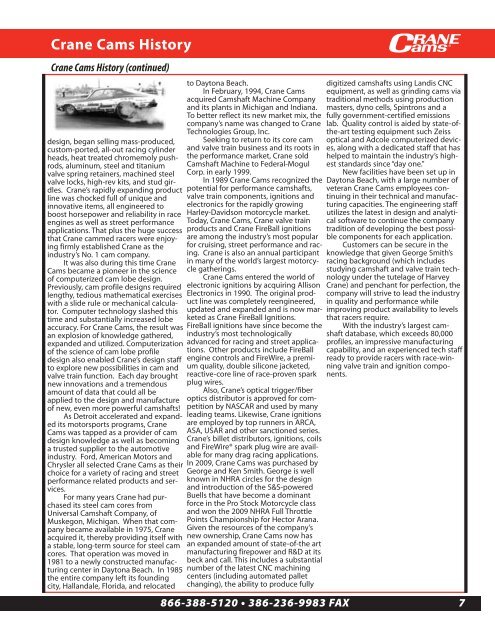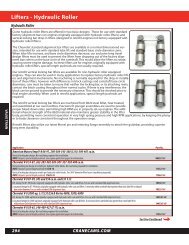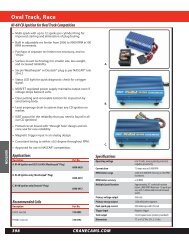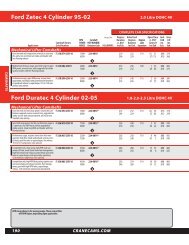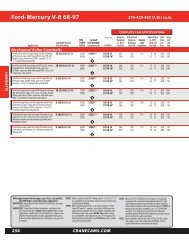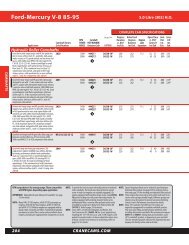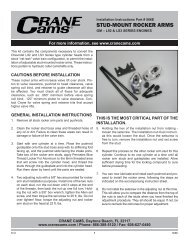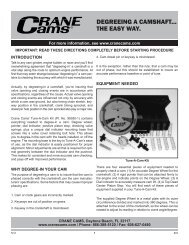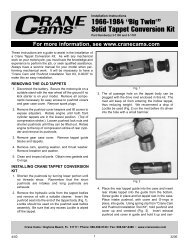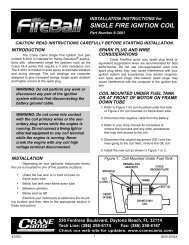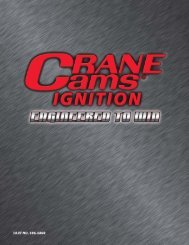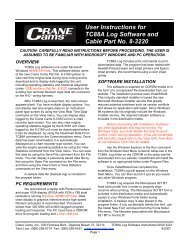2011 - Crane Cams
2011 - Crane Cams
2011 - Crane Cams
You also want an ePaper? Increase the reach of your titles
YUMPU automatically turns print PDFs into web optimized ePapers that Google loves.
<strong>Crane</strong> <strong>Cams</strong> History<br />
<strong>Crane</strong> <strong>Cams</strong> History (continued)<br />
design, began selling mass-produced,<br />
custom-ported, all-out racing cylinder<br />
heads, heat treated chromemoly pushrods,<br />
aluminum, steel and titanium<br />
valve spring retainers, machined steel<br />
valve locks, high-rev kits, and stud girdles.<br />
<strong>Crane</strong>’s rapidly expanding product<br />
line was chocked full of unique and<br />
innovative items, all engineered to<br />
boost horsepower and reliability in race<br />
engines as well as street performance<br />
applications. That plus the huge success<br />
that <strong>Crane</strong> cammed racers were enjoying<br />
firmly established <strong>Crane</strong> as the<br />
industry’s No. 1 cam company.<br />
It was also during this time <strong>Crane</strong><br />
<strong>Cams</strong> became a pioneer in the science<br />
of computerized cam lobe design.<br />
Previously, cam profile designs required<br />
lengthy, tedious mathematical exercises<br />
with a slide rule or mechanical calculator.<br />
Computer technology slashed this<br />
time and substantially increased lobe<br />
accuracy. For <strong>Crane</strong> <strong>Cams</strong>, the result was<br />
an explosion of knowledge gathered,<br />
expanded and utilized. Computerization<br />
of the science of cam lobe profile<br />
design also enabled <strong>Crane</strong>’s design staff<br />
to explore new possibilities in cam and<br />
valve train function. Each day brought<br />
new innovations and a tremendous<br />
amount of data that could all be<br />
applied to the design and manufacture<br />
of new, even more powerful camshafts!<br />
As Detroit accelerated and expanded<br />
its motorsports programs, <strong>Crane</strong><br />
<strong>Cams</strong> was tapped as a provider of cam<br />
design knowledge as well as becoming<br />
a trusted supplier to the automotive<br />
industry. Ford, American Motors and<br />
Chrysler all selected <strong>Crane</strong> <strong>Cams</strong> as their<br />
choice for a variety of racing and street<br />
performance related products and services.<br />
For many years <strong>Crane</strong> had purchased<br />
its steel cam cores from<br />
Universal <strong>Cams</strong>haft Company, of<br />
Muskegon, Michigan. When that company<br />
became available in 1975, <strong>Crane</strong><br />
acquired it, thereby providing itself with<br />
a stable, long-term source for steel cam<br />
cores. That operation was moved in<br />
1981 to a newly constructed manufacturing<br />
center in Daytona Beach. In 1985<br />
the entire company left its founding<br />
city, Hallandale, Florida, and relocated<br />
to Daytona Beach.<br />
In February, 1994, <strong>Crane</strong> <strong>Cams</strong><br />
acquired <strong>Cams</strong>haft Machine Company<br />
and its plants in Michigan and Indiana.<br />
To better reflect its new market mix, the<br />
company’s name was changed to <strong>Crane</strong><br />
Technologies Group, Inc.<br />
Seeking to return to its core cam<br />
and valve train business and its roots in<br />
the performance market, <strong>Crane</strong> sold<br />
<strong>Cams</strong>haft Machine to Federal-Mogul<br />
Corp. in early 1999.<br />
In 1989 <strong>Crane</strong> <strong>Cams</strong> recognized the<br />
potential for performance camshafts,<br />
valve train components, ignitions and<br />
electronics for the rapidly growing<br />
Harley-Davidson motorcycle market.<br />
Today, <strong>Crane</strong> <strong>Cams</strong>, <strong>Crane</strong> valve train<br />
products and <strong>Crane</strong> FireBall ignitions<br />
are among the industry’s most popular<br />
for cruising, street performance and racing.<br />
<strong>Crane</strong> is also an annual participant<br />
in many of the world’s largest motorcycle<br />
gatherings.<br />
<strong>Crane</strong> <strong>Cams</strong> entered the world of<br />
electronic ignitions by acquiring Allison<br />
Electronics in 1990. The original product<br />
line was completely reengineered,<br />
updated and expanded and is now marketed<br />
as <strong>Crane</strong> FireBall Ignitions.<br />
FireBall ignitions have since become the<br />
industry’s most technologically<br />
advanced for racing and street applications.<br />
Other products include FireBall<br />
engine controls and FireWire, a premium<br />
quality, double silicone jacketed,<br />
reactive-core line of race-proven spark<br />
plug wires.<br />
Also, <strong>Crane</strong>’s optical trigger/fiber<br />
optics distributor is approved for competition<br />
by NASCAR and used by many<br />
leading teams. Likewise, <strong>Crane</strong> ignitions<br />
are employed by top runners in ARCA,<br />
ASA, USAR and other sanctioned series.<br />
<strong>Crane</strong>’s billet distributors, ignitions, coils<br />
and FireWire® spark plug wire are available<br />
for many drag racing applications.<br />
In 2009, <strong>Crane</strong> <strong>Cams</strong> was purchased by<br />
George and Ken Smith. George is well<br />
known in NHRA circles for the design<br />
and introduction of the S&S-powered<br />
Buells that have become a dominant<br />
force in the Pro Stock Motorcycle class<br />
and won the 2009 NHRA Full Throttle<br />
Points Championship for Hector Arana.<br />
Given the resources of the company’s<br />
new ownership, <strong>Crane</strong> <strong>Cams</strong> now has<br />
an expanded amount of state-of-the art<br />
manufacturing firepower and R&D at its<br />
beck and call. This includes a substantial<br />
number of the latest CNC machining<br />
centers (including automated pallet<br />
changing), the ability to produce fully<br />
digitized camshafts using Landis CNC<br />
equipment, as well as grinding cams via<br />
traditional methods using production<br />
masters, dyno cells, Spintrons and a<br />
fully government-certified emissions<br />
lab. Quality control is aided by state-ofthe-art<br />
testing equipment such Zeiss<br />
optical and Adcole computerized devices,<br />
along with a dedicated staff that has<br />
helped to maintain the industry’s highest<br />
standards since “day one.”<br />
New facilities have been set up in<br />
Daytona Beach, with a large number of<br />
veteran <strong>Crane</strong> <strong>Cams</strong> employees continuing<br />
in their technical and manufacturing<br />
capacities. The engineering staff<br />
utilizes the latest in design and analytical<br />
software to continue the company<br />
tradition of developing the best possible<br />
components for each application.<br />
Customers can be secure in the<br />
knowledge that given George Smith’s<br />
racing background (which includes<br />
studying camshaft and valve train technology<br />
under the tutelage of Harvey<br />
<strong>Crane</strong>) and penchant for perfection, the<br />
company will strive to lead the industry<br />
in quality and performance while<br />
improving product availability to levels<br />
that racers require.<br />
With the industry’s largest camshaft<br />
database, which exceeds 80,000<br />
profiles, an impressive manufacturing<br />
capability, and an experienced tech staff<br />
ready to provide racers with race-winning<br />
valve train and ignition components.<br />
866-388-5120 • 386-236-9983 FAX 7


